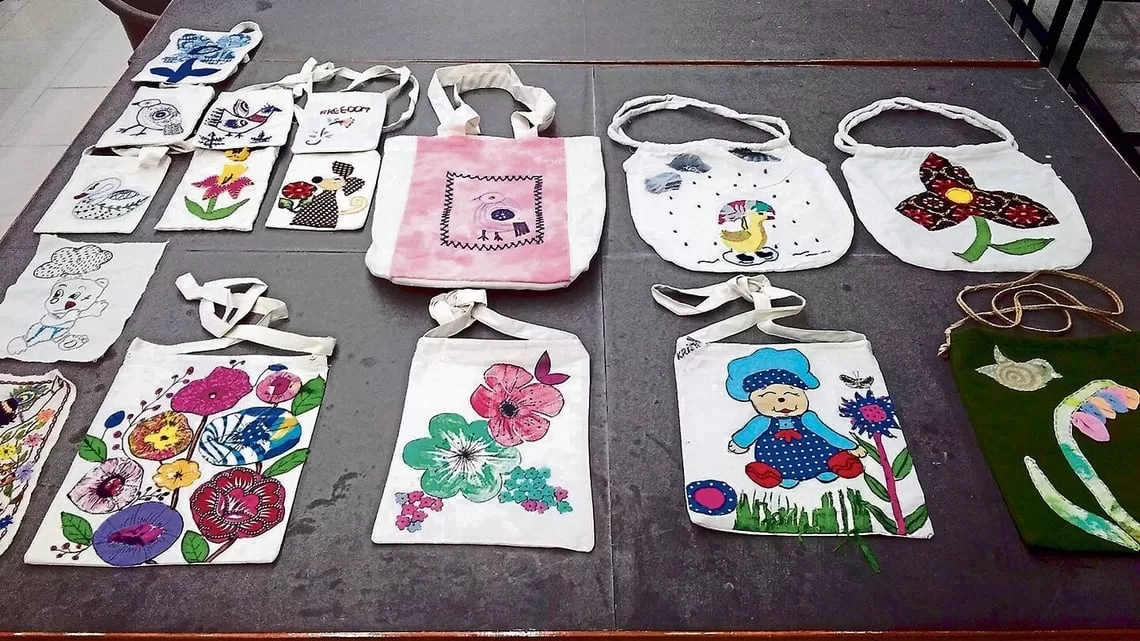Women prisoners of Sub Jail No.6 are using design as a language of freedom and confidence
“What do you think of my dress?” M asks as she enters the Design Lab in one of South Asia’s largest prison complexes, Tihar Prisons, in west Delhi.
The lab is essentially a classroom with about 20 electric sewing machines, where all the inmates of Tihar Sub Jail No.6—meant for women—can enrol for a free, three-month fashion design course offered by the Delhi-based Pearl Academy. They can learn embroidery, stitching and study how to design garments, bags and other accessories. M is one of the 35-odd students “graduating” on the day I visit.
“This is my design. Can you believe I had never picked up a needle in my life before this course?” M, in her 50s, says, twirling to offer a view of her batik-printed co-ord set. It matches her pale pink lipstick, which she has also used as a cheek tint, and the rubber band holding her hair up in a bun. The top, though, has an oddly placed blue flower embroidered on one shoulder. I find the same motif in her other creations, bags and scarves, as well. “Blue was my (late) husband’s favourite colour. It’s only when I am here (inside the lab) that I forget about that one moment of rage that changed my life,” says M, who was jailed 18 months ago for allegedly murdering her husband.
P shows off her red and yellow printed Anarkali suit. Z has a bag with a feather- stitch pattern that depicts the roses in her garden at home. A’s handkerchief has chain-stitch embroidery that faintly resembles the faces of her two children, who are now teenagers. Each design has a unique story to tell.
For the women, the course, first started in 2017, offers escape and confidence: “It allows me to forget why I am here”; “it’s the only time when I am happy”; “it gives me confidence that I can make something out of my life once I step out of here”; “it’s the only time I am not crying”.
They can sell their clothes and accessories to other inmates during a weekly market organised within the premises (the inmates earn monthly wages from the jail authorities for duties like cooking and cleaning). The product prices, decided by jail authorities, range from ₹150-1,200, depending on the item. The money earned goes to the designer. They seem to earn around ₹500 a month on average.
Once they leave prison, they can approach the academy for help in getting a job or set up their own tailoring business. The academy says it has helped, for instance, one woman get a job with a fashion studio in Delhi. So far, over 160 Sub Jail No.6 inmates have received certificates of completion from the academy; the lab was shut in 2021-22. M’s is the first batch to finish the course post covid-19.
After serving a four-year jail term in a murder case, S now runs a tailoring business from her south Delhi home, making clothes for family and friends. Since she started two years ago, she has been earning around ₹15,000 a month. “I have one machine and about 10 clients. I am very happy; never ever in my dreams did I imagine that I could be independent,” says S, who watches YouTube videos for design inspiration.
Two academy instructors—whose names, like those of the inmates, can’t be dis- closed—teach everything, from the different kinds of stitches to how to dye shibori textiles and cut cloth for a palazzo or an off-shoulder dress. Classes are held Monday-Friday, 9am-4pm.
This initiative started under our Here for Good” campaign, says A.Maurizio Grioli, the dean of Pearl Academy. “Fashion is a very fascinating world… it allows people to dream, probably that’s why people are interested in the course so much.”
The inmates’ creations are displayed on mannequins across the Design Lab: dresses, gowns, salwar-kameez, even a corset top. “We introduced more Western designs once we had international inmates,” says one of the teachers, referring to prison- ers of African descent.
Each machine has been redesigned in such a way that it can’t be used as a weapon. “Till date, there’s been no accident or any instance that would make us think twice about running this programme,” says Pearl Academy professor Bela Gupta. “Each year, we are seeing a good number of around 30 women enrolling for the course. What makes this course work is the play with colours and threads. It gives them a chance to dance with their thoughts while being confined and away from their family, especially kids.”
Several studies confirm that a creative activity can boost mood and well-being, more so in a confined environment. At Tihar, a non-profit also offers to teach beauty parlour skills but the 35 women I met preferred stitching since it doesn’t need much investment to start a tailoring business when they leave the jail.
“This is a skill-building exercise to help the inmates become more entrepreneurial,” says Gupta, adding that they plan to scale the project to other jails soon.
When M was called on stage to receive her certificate, she said, “When I stitch, I am not just working towards making a pretty kurta or a shirt. I am also mending my heart…telling it that it’s okay to dream of a better life.”






Get your piece of Bali now